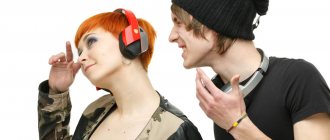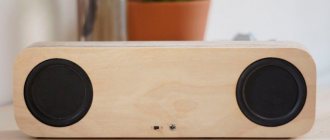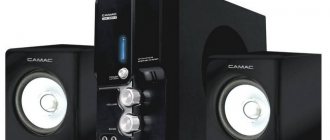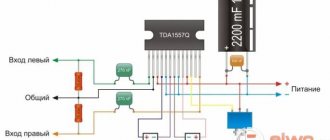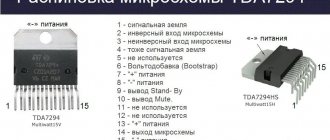Apply for a free card and get 500 ₽ from AudioGeek
Owners of full-size and on-ear headphones will sooner or later be faced with the fact that the ear pads lose their original appearance and consistency. It so happens that there is often no way to find or buy new ear pads. Therefore, today we will look at how to sew ear pads with your own hands.
This article is a rewrite of my first article, written specifically for the audio forum lossy.ru. It was decided to rewrite it after discovering it on other Internet resources. Here they are, copyrights in RuNet))
The size and shape of the ear pads affect the sound character of the headphones. If you decide to sew ear pads with your own hands as a replacement for worn ones, then you should choose the sizes based on the original ones.
I sewed ear pads for the TDS-5 being restored, so the sizes were chosen based on recommendations from various sources. I tried to make them as thin as possible and with as large an internal diameter as possible.
To sew ear pads with your own hands you will need:
- To a barb of thin skin or leatherette
- Foam rubber that can be removed from the ear pads of other headphones. Unfortunately, a washing sponge will not work here; the foam rubber should allow air to pass freely. The best way to check is to try to blow through it
- Sewing supplies
- Artboard for creating patterns
- Compass marker, for marking cardboard
More information about the material used
When choosing a material, you should try to find it as thin as possible. In my opinion, sewing from leatherette is easier. In fact, finding it on sale is easier and cheaper. It is better to choose one that has a fabric base. You can also sew from velor - it all depends on your taste and the ability to get the material.
Both leather and leatherette are most often sold by the meter. The used leatherette was sold in rolls, about a meter wide. I bought 20 centimeters and even then there was about half of the material left. As for the price of the issue, such happiness cost about 2 dollars.
Knitted analogue
Many people who like to listen to music on headphones use knitwear to repair them, most often socks. Their diameter most closely matches the size of the plastic round parts of the headphones. It’s better to take warm knitted socks with an unstretched elastic band, because that’s exactly what we’ll need. By cutting off this part of the knitted product, we get a pipe measuring 10-14 cm.
To prevent the threads from fraying on the cut, it is stitched over the edge with simple cotton threads. On the other hand, the edge is processed at a knitting factory, so the preparation for repairing ear pads for headphones with your own hands is completed. All that remains is to roll one end and the other inward and pull it over the circle of headphones.
Sound access is free, and the soft jersey does not irritate. Fast, convenient and accessible, it's suitable for even the laziest listeners.
It's time to sew!
We combine the cut out rings with each other and sew them with small stitches along the inner edge. For greater fixation, the rings were glued together with tape. You can use clothespins, the main thing is to prevent displacement relative to each other.
If your household has a sewing machine, it would be a good idea to use it.
Using the foot on my sewing machine as a guide, I sewed a little further from the edge than with my hands. There is nothing wrong with this, it’s just that the inner diameter will be a little larger, and the ear pad itself will be thinner.
If you don’t have a machine, you can manually flash it a couple of times. The main thing is that the seam is uniform and there are no gaps when stretched.
Since the stitched workpiece will turn inside out, it will be better to cut off the excess along the inner edge.
Microphone from headphones
If you are wondering how to make a microphone from headphones, then the answer is quite simple.
Many headphones (the speakers that produce sound) already have factory microphones installed. They allow you to communicate even on a computer without using a real microphone.
To do this, just insert the headphones into the computer, and then switch to the microphone.
Add thickness
In order for the ear pads to be thick, we will need to cut another strip, the width of which will determine the future thickness. Just as before, leave 2-3 mm for the seam.
From the recommendations, I chose a thickness of about a centimeter, the remaining half a centimeter was left for the seams.
The length of the strip was cut with a margin, by eye. For a more accurate calculation, you should pick up a calculator and remember your school years, in particular what
Ambient length = 2 * 3.14 * outer radius of embouchure
For a radius of 37.5 it turned out to be about 23.5 cm. So we cut out 25 cm and don’t worry.
Sew the edge of the strip to the edge of one of the rings.
When the circle is completed, leave an overlap of 0.5-1 cm and cut off the excess part of the strip. This is what it looks like after stitching on a sewing machine.
It's better to buy headphones or make it yourself
It depends on how well you handle technology. If it’s easier for you to make your own headphones, then it’s better to buy the necessary components.
But you can buy inexpensive headphones that are of good quality, so you don’t need to waste effort. However, if you decide to make them yourself, then patience is required.
Insert foam rubber
Our blank is beginning to resemble an embouchure more and more. Now it comes to foam rubber.
We thread the workpiece into the foam ring and install it. The matter remains small.
The second seam will be on the outside. Therefore, it is worth sewing the strip with the second ring by attaching them with the wrong sides to each other. Do not allow the seam to go through the foam.
After the next circle is completed, we move the embouchure in different directions. This is necessary so that the foam rubber is evenly distributed inside.
What about wireless headphones
Wireless headphones can be assembled. How to make wireless headphones? For this we need a couple of tools.
What is necessary
- The wire
- bluetooth adapter
- Charging device.
We carry out the assembly
- First you need to insert the Bluetooth adapter into the charger.
- We connect it to the stereo system.
- We open Bluetooth in the device through which music will be played.
- Let's connect and listen to music.
Now we have learned how to make Bluetooth headphones inexpensively and practically.
How to choose the right components
The design of standard headphones includes the following components:
- Plug with a diameter of 3.5 mm. Its other name is the TRS connector, on the metal surface of which several contacts can be found. Due to them, a linear signal is received from any sound source, be it a computer or a telephone. Depending on the type of headphones, the number of receiving contacts also changes. Stereo headphones have three as a standard, headsets have four, and the most common devices with mono sound are equipped with only two. This is one of the most important points, since the correct selection and connection guarantee the functionality of the gadget at the output.
- The headphone cable can be different - flat, round, single or double. In some models it connects to only one speaker, in others it connects to both. The cable contains a set of “live” wires with bare grounding. The wires are painted in conventional colors so that the input for connection cannot be confused.
- The speaker is the heart of any headphones; depending on the width of the sound sector, the tonality and spectrum of the sound changes. Different speakers can be targeted at different audio frequency ranges. In standard headphones, these are low-power models with minimal sensitivity. It will be easiest to take the speakers from old headphones along with a plastic case. When cutting them off, it is worth leaving a little cable for further connection.
The design of any headphones itself is simple enough that even a beginner can figure it out. The most important thing when creating a new gadget from several non-working ones is to select really functional components. For this purpose, diagnostics of spare parts is mandatory .
Plug
In this case, there are two different options:
- Simple headphones without a microphone. Four wires are connected to the plug: plus and minus from each speaker. To make assembly more convenient, the negatives are twisted into a common bundle and thus get 3 cores, which need to be fixed to certain places using a soldering iron.
- Headphones with microphone. In this case, the plug has four contacts: one for each speaker, the second for the microphone, and a contact for ground. It must be said that the color of the wires may vary depending on the headset manufacturer and this parameter is quite arbitrary. The left speaker cable may be green. The cable from the right speaker is always marked red. Ground - copper wire.
Speakers
This is the main element of any headset; the sound quality will depend on it. The speaker can belong to any of the reproduction spectrums, low- or high-frequency, dome or regular.
But, as a rule, the headphones have the simplest speaker installed. It is not distinguished by increased sensitivity or power, but is quite reliable and unpretentious to use.
It is very difficult to purchase a speaker separately, it is even more difficult to make one without special equipment, there is no need to create unnecessary complications, you can simply cut off the required speakers from other headphones. In this case, it is necessary to cut the cable evenly so that the copper core does not split. It won't be difficult to disassemble unnecessary headphones and use the elements to make new ones.
Cable
The cable is made in the form of a flat, long black strip or a round wire. Manufacturers produce single and double wires - it will depend on whether the cables are connected to one speaker or two.
Reference! Under the insulation there are copper conductors - right/left channel, ground wire. Most often, the wires are marked in different colors.
Key moment
This part of the headphones is in direct contact with the human body, which means it is largely responsible for the feeling of comfort or discomfort.
In addition, the ear pads actually form an acoustic chamber for which the headphone emitter operates. Well, the third factor that directly depends on them is the degree of suppression of external noise. Unless, of course, we are talking about open headphones. All this applies equally to both in-ear and full-size models. At first glance, their ear pads have nothing in common - they also differ tens of times in size. But from the point of view of the functions they perform, they are as close as possible.
The essence of the question: For sound, ear pads are no less important than speakers.
Life hack: If you want to choose the right headphones, you can’t do without trying them on; you don’t buy clothes or shoes based on the picture.
Leather, but not crocodile
The choice of exterior finishes is quite wide. The best option (in terms of comfort and noise insulation) is considered to be genuine leather. But quality faux leather can be just as good in terms of wearing feel and durability. And it is no longer possible to distinguish good artificial leather from natural leather. Currently, the vast majority of manufacturers use high quality artificial leather. Good leather ear pads, regardless of the origin of the material, are pleasant to the body and cause a greenhouse effect only when worn for a long time in the warm season. To eliminate the latter, some manufacturers perforate the leather of the ear pads, which not only provides natural ventilation, but also reduces the degree of noise insulation.
Low-quality leather substitutes are stiffer and less comfortable to the touch, and may have folds that reduce the degree of insulation from external noise. The cheapest artificial leather can be soft, but it rustles unpleasantly when in contact with the body. However, a price alternative to such a finish can only be considered bare polyurethane foam or, more simply put, foam rubber. By the way, it is also not particularly comfortable and rustles when you touch the body.
The second most common material is velor or velvet. In terms of tactile sensations and performance properties, artificial suede Alcantara is close to them. Acoustically transparent fabric is used less frequently, most often in over-ear headphones, in which the ear pads have the shape of a solid pillow. All these materials are more pleasant and comfortable during prolonged use, and have better breathability than leather. No wonder velvet and velor are often used on professional models. On the other hand, there are also disadvantages: a slightly lower degree of noise insulation, difficulty in maintenance (the skin is much easier to clean).
There are also more exotic versions of ear pads, for example, silicone. But such models, for obvious reasons, did not become popular. They are hot in summer and cold in winter. It's just convenient to wash. There are no other advantages.
The essence of the issue: Finishing determines the degree of comfort. It is not the naturalness that is important, but the quality of the materials.
Life hack: If you like some specific headphones, but don’t like the standard ear pads, remember: in many models they can be replaced (including non-original ones of higher quality).
Headphones with microphone
So, to find out how to make headphones with a microphone, just re-read the article again. Headphones with microphone required. You can make headphones using the method that we described step by step above.
However, if you need headphones with a microphone, then you need to find headphones that have a microphone. Then it will be possible to carry out the task you want to complete.
Remember that in this business you need to be good at soldering and working with micro parts.
Checking the functionality of parts
You can determine the cause of headphone failure at home in several stages:
- It’s worth checking the sound sources themselves - it’s possible that the headphones will work when connected to another device.
- It is worth checking whether the wire plugs have moved away from the contacts, whether the cable is intact and whether the speaker is working. By reconnecting the plugs there is a chance to significantly improve the sound quality.
For one pair of headphones, on average, you will need three non-working sets, which can be used for spare parts if you do not plan to buy wires and other components in the store.
Lots of foam
An alternative to silicone ear pads is foam ear pads. This is a significantly more expensive material, but it also provides a wider range of possibilities. By changing the characteristics of the foam, manufacturers can achieve either the highest noise insulation or the opposite effect - good fixation in the ear with the ability to hear surrounding sounds. The shapes of foam ear pads also come in different shapes. Mostly spherical or truncated cone predominate. Size also matters. The foam used in most cases is heat-sensitive and memory foam. When heated by body heat, they become softer, and after compression they gradually return to their previous shape. This increases the degree of physical wearing comfort. Although some people find any foam ear pads uncomfortable due to specific tactile sensations.
But what is absolutely objective and indisputable is their higher cost. A set of foam ear pads costs significantly more than a similar set of silicone ear pads. However, foam ear pads are not durable and require regular replacement. Porous material gets dirty more easily and quickly, and it is very difficult to wash, clean and disinfect it without damaging it. Over time, the foam begins to crumble and becomes unusable. In short, the love for foam attachments becomes an additional expense.
The essence of the question: Pleasure cannot be cheap. You have to pay for comfort.
Lifehack: Cheaper in bulk. Decide on your favorite model of ear pads and buy them in packs of several pairs.
